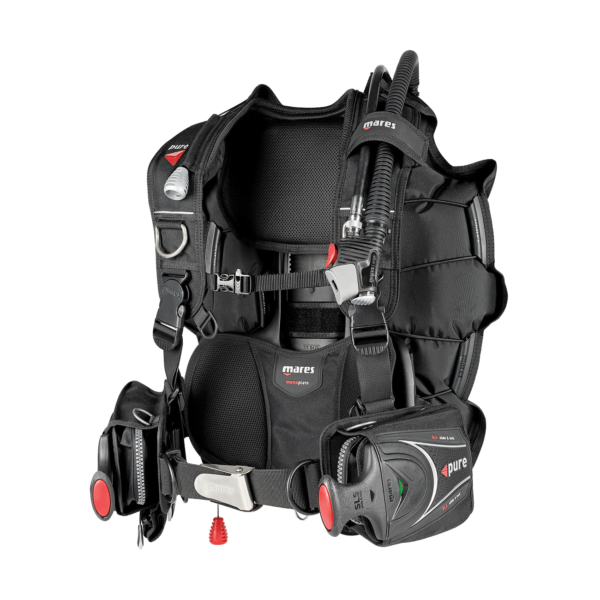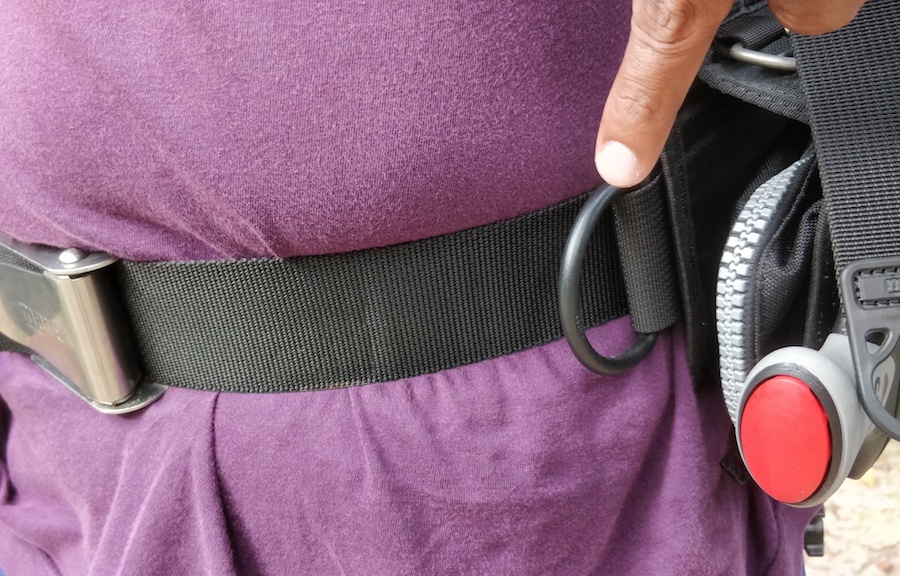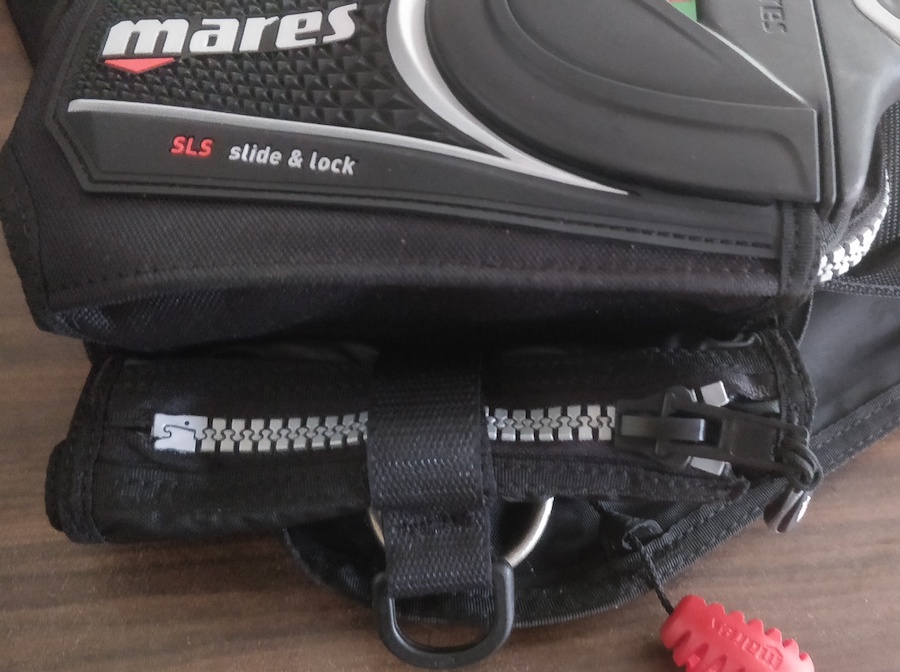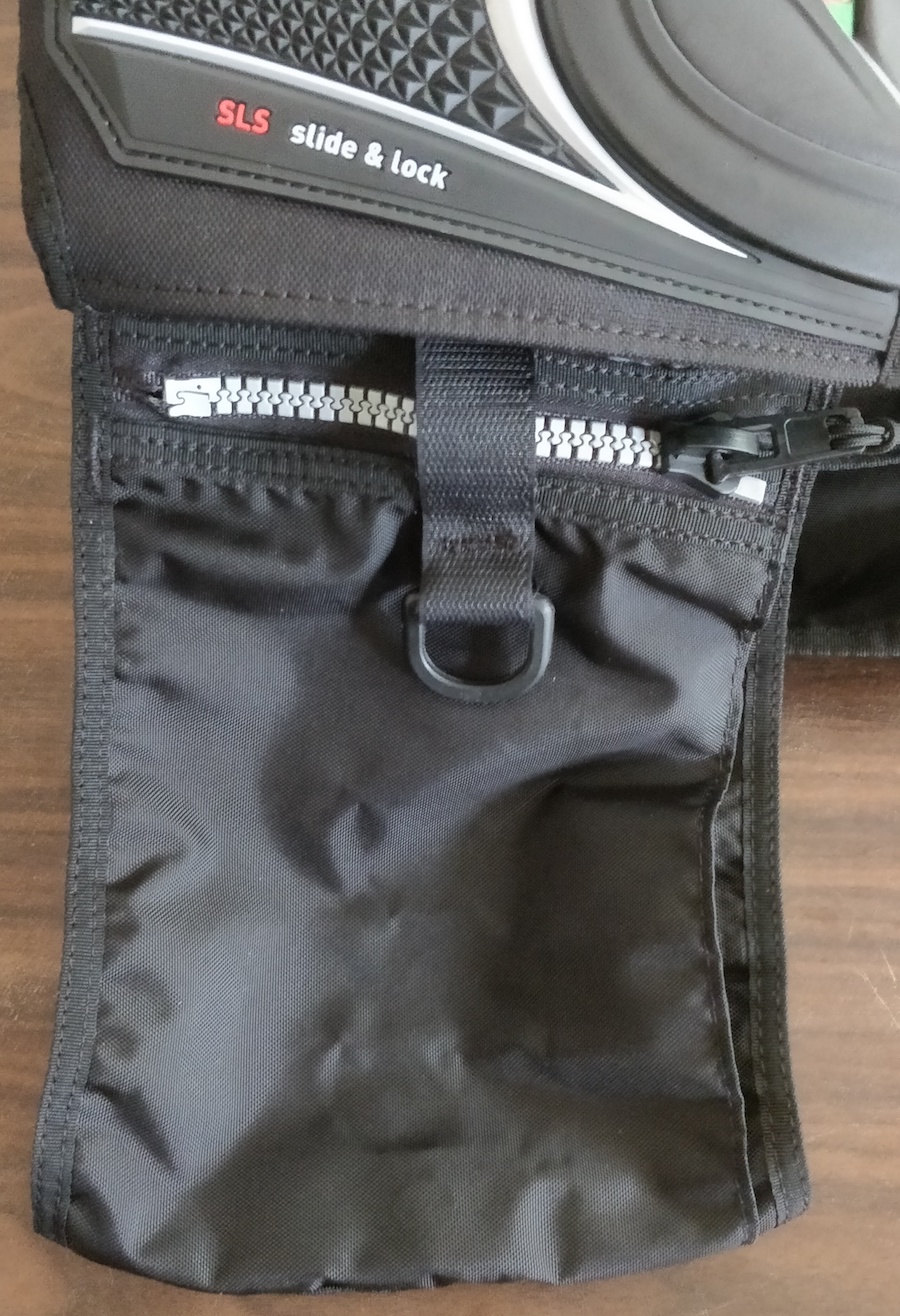Review: Mares Pure SLS BCD
Note: The BCD reviewed in this unit was purchased by us before being reviewed. We did not get any special discounts or other considerations for the review. All the gear we review is based on our personal experiences and we will NEVER recommend a product that we do not believe in – we exist to serve our guests, not manufacturers of scuba equipment.

They say you cannot teach an old dog new tricks, nor can you get an old diver (speaking metaphorically, of course!) to try on new gear. Well, Frodo, my golden retriever proved the first adage wrong and now the pressure is on me.
Some background: though a process of trial and error, I figured out my ideal gear configuration in the late 90s, and have seen no real reason to change it. When it came to recreational BCDs, my preferred brand has always been Seaquest / Aqualung – and that confidence has been time-tested: even today, we use Aqualung BCDs in the dive shop and recommend them without reservations to people looking to buy BCDs.
While we are also a Mares distributor, I have never recommended Mares BCDs so far. A chance conversation with the Mares distributor got me thinking about why this was so. While I am a big fan of their masks, fins (Quattros rock!) and wetsuits, I have never been a fan of their BCDs: I found the entry-level ones to be lacking compared to Aqualung, and higher-end ones to be needlessly fussy and generally, the range to lack the same robustness as Aqualung.
But at the same time, this experience is also quite dated. A lot of things change in that time, and if we are going to recommend gear, we owe it to our divers to make sure our recommendations are based on a broad and up-to-date set of personal experiences.
As it turns out, I was looking to get a new recreational BCD for myself anyway, as my old Aqualung Balance, while still serviceable, was getting a bit tatty after 9 years of (ab)use. So instead of getting the Aqualung Dimension I had been lusting after, I looked up the Mares catalog and picked a Pure SLS BCD instead. I sent the money over and a few days later, I had the BCD in my hands.
And now, here is a review of the BCD, based on several months of ownership and diving.
Note: Before going further, I encourage readers to read the following Buyer’s Guide on How To Select A BCD.
SPECIFICATIONS
The Mares Pure SLS BCD is a mid-end BCD in the Mares line, lying below top-range BCDs like the Quantum and Hybrid, but above more basic models like the Prime and the Rover.

The Mares Pure SLS BCD, with the folding pocket opened
The Mares Pure SLS BCD has the following specifications:
Style: Back-inflation BCD with a central, rigid backplate
Lift: 18kg
Weight: 3.9kg
Streamlined
Swivel shoulder buckles
Weight integrated: Yes, with visual confirmation
Trim pockets: Yes
Adjustable waist strap
Customizable and travel friendly
Fabric: Cordura 420
MRP: Rs 38,250
Our price: Significantly less (of course) 🙂
On paper, this is a very well-specced BCD. But what does that mean, in terms of usage? Read on.
FIT/COMFORT/FEATURES
A BCD must be comfortable. That’s a very, very essential and non-negotiable requirement. If it doesnt fit properly, you will not enjoy the dive. And that is why most of us dive, right? So what are the elements that go into fit?
The BCD should sit comfortable and snugly tight around the waist, the shoulder straps should be comfortable and the tank should be stable. And nothing should pinch or bite when you wear it.
On this count, the Mares performed very well. The padding on the backplate at the contact points (upper and lower back) made for a very comfortable wearing experience, with the pressure evenly distributed and no extraneous materials adding weight.
The BCD comes with the standard sets of releases and clips.
It uses a buckle and webbing system to tighten at the waist, as opposed to a more traditional velcro strap system. Some people prefer the velcro as it is easier to attach and loosen- after years of diving with a harness, I prefer the buckle-and-webbing system, as it allows you to really modulate the snugness of the waist band. It takes a little longer to get used to, but is well worth it, in my opinion.
On an entry-level BCD, the velcro makes more sense to avoid confusion (and a resultant unhappy outcome) with the weight belt buckle. But as this is a weight-integrated BCD, you are likely not going to be wearing it with a weight belt. So it makes sense to have that buckle there. Mares has paid attention to the details here.

The D-ring is used to tighten/loosen the waist strap
The BCD also comes with the traditional chest clip (in case your straps are too far out on your shoulders) and the 2 quick releases, one on each shoulder.
Thankfully, the shoulder clips are the swivelling type – these improve the ergonomics and comfort significantly by allowing the straps to follow the natural curves of your torso. This means no pulling, pinching or biting in the shoulders. It’s a small thing but once you get used to it, you’ll notice it every time you dive with a BCD with regular quick-release clips.

The swivelling clips at the shoulders allow the straps to follow your torso’s natural curves
The BCD also has 2 clearly-marked emergency air dumps – one on the usual right front shoulder and the other on the right bottom. Both come with large handles which are easily located by touch – an essential feature (if you do lose your buoyancy and are going up, you want the emergency air dump to be VERY easy to find). The air dumps allow for a surprising amount of modulation – many people, once they get used to their BCDs, use the rear air dumps to adjust their buoyancy on the fly: it is more convenient than bringing yourself to a more vertical position, raising your deflator hose and releasing the air. Some dump valves allow this more easily than others – thankfully, the Mares is one of them.
In terms of attachment points for accessories – you get lots! The Mares Pure SLS has D-rings in the following locations:
- 2 sturdy steel D-rings, one on each shoulder
- 1 plastic D-ring at the bottom of the right shoulder strap
- 2 steel D-rings on top of the weight pockets
- 2 steel D-rings at the bottom front of the BCD, under the weight pockets
- 1 plastic D-ring at the bottom of the wings, at your lower back (for attaching SMBs or even a jerry-rigged crotch-strap)
If you need more D-rings than this, you should be in a submarine!
In addition, there is a rolled-up pocket underneath the right integrated weight pocket, which you can unroll to expand. This has a surprisingly amount of capacity and is fairly useful. In yet another nod to sensible ergonomics, it doesnt open via zipper – there is a velcro strap and a D-ring, allowing for one-handed opening of the pocket

Folding pocket – notice the d-ring and velcro release

Carrying pocket opened
One minor area where I felt the BCD missed out – attachment points for the SPG and octopus. Now, my BCD came with a 2-hose retainer clip, so you could (and I did) use this to attach both the SPG and the octopus.
But I am a big fan of looping the octopus hose on a retainer around the right shoulder – this puts it in a very convenient position to grab and deploy in one smooth motion. On some Aqualung BCDs, you can slip a loop of the octo hose into the BCD sleeve itself – other BCDs have a bit of elastic there which serves the same purpose – providing a place to loop the octo hose. Similarly, a small loop of velcro around the left weight pocket could have provided a suitable point for retaining the SPG.
The Mares Pure SLS lacks either of these. Yes, you can use a clip (or 2), but it isnt as neat a solution as having the retainers built into the BCD itself. Yes, I agree that this is a very minor issue but for a BCD that otherwise has a lot of nice litte ergonomic touches, this one would have been very nice to have as well.
BUOYANCY, LIFT & STREAMLINING
I am a big fan of back-inflation BCDs. I find them to be significantly more comfortable and allowing for better trim than jacket style BCDs. Yes, they take a little bit of practice to get used to, especially on the surface, but the payoffs are well worth it, in my opinion.
The 18kg of lift is more than ample for most kinds of diving, from tropical warm water to cold water. The downside of most large-lift back inflation BCDs is that the wings can often be too large and flap around in the water even when not full, thereby adding to the drag. The Mares Pure SLS comes with a neat little feature: elastic bands sewn into the edge of the wings, which pull it in closer when deflated.
Use of bungee cords in wings has always been a contentious topic among tech divers, but the implementation here is very sensible: it doesnt so much compress the wings, but merely pulls the edges in close. So in the event of a leak, it will not compress your wings and cause them to lose air faster.
Even small reductions in drag can have massive payoffs in ease of swimming and reduced air consumption, so this is a very nice and under-rated little touch from Mares. Well done!

The bungees runs along the length of the wings and hold the edges close to your body, thereby preventing it from flapping around in the water and adding drag
TRAVEL FRIENDLY
This is not an ultra-light travel BCD.
Mares states the weight of the BCD as 3.9kg, but on my scales, it showed up at over 4kg. That’s a fairly chunky BCD, compared to some of the lighter travel BCDs like the Aqualung Zuma. Also, due to the rigid backplate, it doesnt fold up into a tiny package either.
But my general approach is – first, the BCD should be suitable for diving (features, comfort, trim). Only once you short-list a list of candidates which meet this requirement should you worry about weight.
There is no point taking a lighter travel BCD with you if you dont enjoy it in the water. Now obviously, all else being equal, you want the lighter BCD. But 2kg more isnt the end of the world – it is very easy to pack a 20kg bag which has all your dive gear as well as clothes for a 7-10 day dive holiday. So dont sacrifice your primary usability for this reason.
STURDINESS/RELIABILITY
The BCD is made of Cordura 420 fabric.
Now generally speaking, I am a big fan of 1000-denier BCD construction, as that fabric not only lasts forever, but also retains its color for a very long time. Lower-denier fabrics tend to fade faster – or atleast, used to.
That said, 1000-denier fabric is becoming harder and harder to find these days, except on top-of-the-line models, while 420 and 840 denier fabric is becoming increasingly sturdier and fade-resistant. Certainly, Cordura 420 is certainly a very robust fabric and the popular choice for a lot of gear intended for rugged use. So from that point of view, there is certainly nothing to fault.
Given that most BCD owners are not going to have their BCDs going out daily, 350+ days in a year, and the improvement in quality of 420 or 840 denier fabric, the choice of fabric is probably less of a determining factor these days.
Long-term reliability of the BCD remains to seen, but so far, everything looks to be quality – from the zippers to the clips to the stitching.

High quality zippers, sturdy hardware and quality stitching on display
TRIM POCKETS AND INTEGRATED WEIGHTS
Getting comfortable in the water requires not just good buoyancy but also good trim. Buoyancy is relatively easy – but achieving good trim requires finding the proper location for your weights, so that bring your center of buoyancy and your center of gravity together. Since each of us varies in height, weight and body type, this requires the ability to move the weights around.
As I mention in the article on “How to Choose a BCD: A Buyer’s Guide”, I strongly recommend that someone who is buying a BCD pick on with both integrated weights and trim pockets: these 2 features on your BCD gives you a lot of options in terms of how to position your weights and thereby achieve good trim.
The Mares BCD has both trim pockets AND integrated weight releases, as is standard for most BCDs in this price range. However, there are a few key differences between how Mares has implemented them, versus most others.
For one, the Mares weight pockets are removable. This is fantastic for those of us who dive with 3mm wetsuits and dont use a lot of weight – if you are only diving with 1-2kg of weight, you may decide to put it entirely in your trim pockets and remove the entire weight pocket system, thereby streamlining your gear more.
Secondly, the trim pockets are almost in line with the weight belt. Honestly, this one surprised me when I saw it. The whole point of trim pockets is to allow a diver to move some weights higher up, moving his center of gravity towards his head and thus countering a tendency for the legs to go down. Having trim pockets in line with the integrated weights, as opposed to higher up (around the shoulders) seems counter-intuitive.
There seems to be a greater tendency among manufacturers to do this, though. A couple of Aqualung BCDs also have their trim pockets near the floating ribs, as opposed to around the shoulders. The proof of pudding, for this, of course would be the diving. [Spoiler alert: I went in fully expecting it to be an issue but much to my surprise, this turned out to be a non-issue. More on this later.]
Lastly, the Mares weight system has a locking mechanism. As with all weight systems, the release is a Quick Release action which can be operated with one hand – you grab the weight system’s handle and pull, and it comes out, allowing you to ditch it if you have an emergency. That is to be expected – you want the emergency release system to be as simple as possible.
However, unlike most integrated weight systems where you just jam the weight pocket back in to replace it, Mares has adopted what they call a “Slide and Lock” system. When replacing the weights, you have to pull the handle out into “unlock” position. Then after you insert the weight pocket into the retainer, you have to push the top of the handle to “lock” it. When it is locked, the display tab in the weight system shows Green. If it is not locked correctly, it shows as Red.

The weight pocket showing with the Slide & Lock mechanism (the red/green part)
Accidental ditching of weights due to improper replacement is one of the more common failure points of integrated weight assemblies. And obviously, depending on the amount of weight dropped and the diving situation, the outcome of this can be very dangerous.
What Mares’s locking mechanism does is remove this risk. Take a look at the 2 photos below. In both cases, the weight pocket looks visually secure, right? However, in one case, it can just slide and fall out whereas in another, it is locked in place. A quick glance at the BCD’s weight system window will tell you which is which – green is go, red is danger.

A properly-locked weight pocket – the weight will not fall out accidentally

An improperly-locked weight pocket – even though the pocket looks secure visually, it isnt locked in and the weight can fall out when diving
IN THE WATER
All the features in the world are meaningless when it comes to how a BCD handles in the water. And not to put too fine a point on this – the Mares Pure SLS blew my mind, that’s how great it was.
As someone who is used to diving with a backplate/wings, I am used to my rig being exceedingly solid and stable. Every recreational BCDs I have used to so far falls short in this area – admittedly, we are not talking about a huge difference and I can adjust to it very easily: but it is there and I do notice that difference.
Well, until now. Between the swivelling shoulder harness, comfy back pads and a convenient tightening mechanism for the waist band, the Mares Pure SLS wrapped around my body like a cocoon and felt as solid/stable as my backplate rig. In simple terms, it felt that my body and the BCD was a single unit, as opposed to me being inside a BCD. Did this change my air consumption or make me a better diver? No. But it just felt a lot nicer. And that is not insignificant.

A view of the back of the BCD: despite the tank cut-out not being curved, the tank is remarkably stable on the back, and not at all prone to moving
The second thing that took me aback was the trim. My legs tends to be very prone to sinking and i generally need to move some weight closer to my shoulders to counter this. Given what i wrote earlier about the trim pockets being inline with the weight system, I was expecting it to be hard to achieve neutral trim.
But right away, off the bat, it felt as though this BCD has been designed specifically for me. I got in the water, i turned to a horizontal position… and i stayed there. Again, getting this with a new BCD is something that usually takes me a few dives to get right and often involves doing things like adding 1kg to the tank band. But not here. Right away… NAILED IT!
I have to admit, I did not expect that. I am very, very finicky about my trim and this is the best level of fit and trim I have gotten from a regular recreational BCD, ever. And truth be told, I still don’t understand how I managed it with trim pockets around my waist when i struggle to do so with trim pockets around my shoulders. I can only guess that Mares has taken the overall trim of their BCD into account when deciding where to put the pockets. While I obviously cannot speak for everyone, I’d venture to guess that if it works for me with my absurdly bottom-heavy natural trim, it should work well for most people.
From an operational and ergonomics point of view, the BCD worked as expected – the inflator hose, the emergency releases, the quick release clips: all did their job as expected from a BCD in this category. The buckle-based weight belt was was an improvement over other BCDs, as described earlier.
Deploying the storage pocket was also much easier than on a jacket-style BCD. In most regular BCDs, the storage pocket is around your ribs and the zipper is just under your armpits – with even a moderately-thick wetsuit, it is very difficult to reach and operate this zipper. The zipper for the storage pocket on the Mares was around the hips and so very easy to deploy. Big win for ergonomics.
Lastly, we come to the weight pockets. Here, my response is a little mixed. When i first used the BCD, I didn’t realize Mares had a special locking mechanism (what? RTFM? We don’t RTFM and we don’t stop to ask for directions either). So i pulled out both the weight pockets to test the release tension and slipped them back in when i was done – at which point, they promptly fell out as soon as i let go, causing a few seconds of entertaining acrobatics while i retrieve them. Doh. It took a lot of futzing around before i managed to replace them securely.
Once i came back to shore and had a chance to examine the mechanism, it made a little more sense and I got the hang of it after a couple of tries. That said, I am still somewhat ambivalent about this.
Many dive manufacturers, including Mares, have at times made pointlessly complicated stuff that, while well-engineered, tries to provide solutions to problems no one really has (anyone remember the Mares Hub?). This system is definitely a little more complicated to replace – and while it may give a clear positive indicator when done right, it is also prone to being done wrong if you are not careful. Is it really needed?
On the other hand, I have to admit – my opinion is clouded by the fact that I show weight belt and integrated weight removal/replacement on a regular basis while teaching. I have decades of muscle memory built up on how to do this, and changing that is something that i dont like to do without good reason (and Frodo also hates moving from his particular spot under the fan and will bark if I leave something there that prevents him from doing so. Hmmm).
However, for someone who doesnt have that pre-existing muscle memory, who will not be ditching/donning weights on a regular basis, this may not be a bad idea. There is one extra step when you attach the weights to the BCD, that’s about it – and if that step reduces the risk of the weights falling out by accident, that’s not a big deal.
Besides, if this weight system bothers you, you can always get rid of it and replace it with an aftermarket, more-traditional integrated weight system, such as the one used by Halcyon. It’s a fairly minor issue, really – I don’t see it being that much of a bother to anyone.
SUMMARY
Regardless of manufacturer, I have always felt that the mid-end range is where real value resides as far as BCDs go. At this price level, you get all the essential features that let you truly dial in the BCD to achieve perfect trim, and none of the excessive bells and whistles that add to the price but are of dubious value in terms of actually improving your diving experience.
The Mares Pure SLS reinforces that. Yes, I have some minor quibbles with it, but those are just that – minor. When it comes to usability, comfort and trim, this is one of the class-leading BCDs out there with lots of small features that add up to one impressive package.
PROS:
- Very comfortable
- Reliable integrated weight system
- Best trim and stability I have ever discovered on a recreational BCD
- Several small features that improve ergonomics and usage experience
CONS:
- Heavy (although that probably contributes to the excellent trim and stability)
- Slightly finicky weight pocket
- Lack of built-in retainers
Recommended? Definitely – this joins our select list of Recommended BCDs.
A caveat – trim is a very personal issue, and we always recommend that you try out BCDs yourself in the water before you buy. If you are coming to the Andamans, or live in Delhi, Bombay or Bangalore, you can try out several of our BCDs for yourself before you buy.


